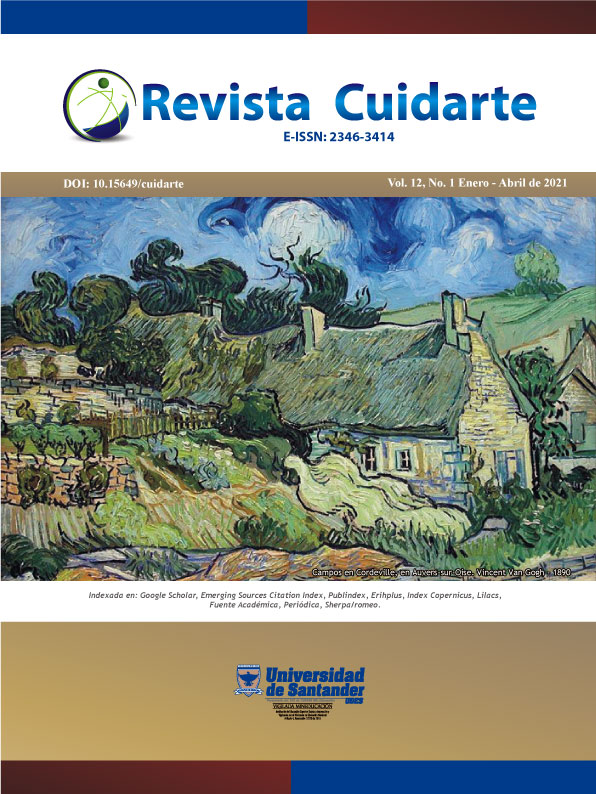Conocimiento y cumplimiento del cuidado de catéteres centrales en un Hospital Mexicano
DOI:
https://doi.org/10.15649/cuidarte.1076Palabras clave:
Enfermería, Catéteres Venosos Centrales, Conocimiento, CumplimientoResumen
Introducción: El uso de catéteres intravasculares constituye una herramienta fundamental para el cuidado de los pacientes, mismos que han sido asociados a las bacteriemias nosocomiales entre un 15 y 30%. El objetivo de estudio fue determinar el nivel de conocimiento y cumplimiento del personal de enfermería respecto al protocolo de cuidados de accesos vasculares centrales. Materiales y métodos: estudio descriptivo, transversal, observacional, que incluyó a 67 profesionales de enfermería que tuvieron a su cuidado pacientes con catéter venoso central. Para la recolección de datos se utilizaron dos instrumentos diseñados a partir del protocolo de cuidados emitido por la Comisión Permanente de Enfermería. Resultados: Se encontró personal con antigüedad laboral promedio de 7.9 años. En conocimiento el 58.2% se ubicó en categoría Conoce, en contraste con el cumplimiento resultando el 91% del personal en categoría Cumple. No hubo correlación entre conocimiento y cumplimiento (rho = -0.181, p = 0.797). Discusión: El cumplimiento contrastó con el conocimiento, sin embargo, los enunciados para ambas variables se relacionaron con la falta de lavado de manos, dejar el tiempo adecuado de los antisépticos y la desinfección de lúmenes a la hora de la manipulación. Conclusiones: La falta de conocimiento y cumplimiento de elementos del protocolo se relacionan directamente con situaciones procedimentales que realiza el profesional de enfermería, por lo que la falta de material e insumos no son factores para no seguir la estandarización del cuidado.
Referencias
Secretaria de Salud. Subsecretaría Sectorial, Comisión Permanente de Enfermería. Protocolo para el manejo estandarizado del paciente con catéter periférico, central y permanente. 1ª Ed. México. 2012. Disponible en: www.salud.gob.mx/unidades/cie/cms_cpe/
Secretaría de Salud. Diario Oficial de la Federación, Norma Oficial Mexicana NOM-045-SSA2-2005 Para la Vigilancia Epidemiológica, Prevención y Control de las Enfermedades. Disponible en: http://dof.gob.mx/nota_detalle.php?codigo=5120943&fecha=20/11/2009
Almazán-Castillo R, Jiménez-Sánchez J. Estandarización de la terapia intravascular a través de las clínicas de catéteres. Revista de Enfermería del Instituto Mexicano del Seguro Social. 2013;21(3):163-169.
Secretaría de Salud. Diario Oficial de la Federación. Norma Oficial Mexicana 022-SSA3-2012, Que instituye las condiciones para la administración de la terapia de infusión en los Estados Unidos Mexicanos. Disponible en: http://dof.gob.mx/nota_detalle.php?codigo=5268977&fecha=18/09/2012
Tomás-López A, Armenteros-Yeguas V, Landa-Portilla B, Baéz-Gurruchaga O, Picón-Santamaría A. Experiencia del Equipo de Terapia Intravenosa (ETI) en la mejora en la gestión del cuidado vascular mediante coordinación entre los distintos niveles asistenciales en la OSI-Araba. International Journal of Integrated Care. 2019;19(4):456. http://doi.org/10.5334/ijic.s3456
Lee Y, Stone P, Pogorzelska-Maziarz M, Nembhard I. Differences in work environment for staff as an explanation for variation in central line bundle compliance in intensive care units. Health Care Manage Rev. 2018;43(2):138-147. http://doi.org/10.1097/HMR.0000000000000134
Secretaria de Salud. Ley General de Salud. Título Quinto. México. Disponible en: http://www.salud.gob.mx/cnts/pdfs/LEY_GENERAL_DE_SALUD.pdf
Asociación Médica Mundial. Declaración de Helsinki; Principios éticos para la investigación médica en seres humanos. Adoptado por la 64a Asamblea Médica Mundial. 2013. Disponible en: http://www.isciii.es/ISCIII/es/contenidos/fd-investigacion/fd-evaluacion/fd-evaluacion-etica-investigacion/Declaracion-Helsinki-2013-Esp.pdff .
Alkubati SA, Ahmed NT, Mohamed ON, Fayed AM, Asfour HI. Health care workers´ knowledge and practices regarding the prevention of central venous catheter-related infection. Am J Infect Control. 2015;43(1):26-30. https://doi.org/10.1016/j.ajic.2014.09.021
Ferrara P, Albano L. The adherence to guidelines for preventing CVC-related infections: a survey among Italian health-care workers. BMC Infect Dis. 2018;18(1):606. http://doi:10.1186/s12879-018-3514-x
Lai CC, Cia CT, Chiang HT, Kung YC, Shi ZY, Chuang YC, et al. Infection Control Society of Taiwan. Implementation of a national bundle care program to reduce central line-associated bloodstream infections in intensive care units in Taiwan. J Microbiol Immunol Infect. 2018;51(5):666-671. https://doi.org/10.1016/j.jmii.2017.10.001
Abu Sharour L, Subih M, Yehia D, Suleiman K, Salameh AB, Al Kaladeh M. Teaching module for improving oncology nurses' knowledge and self-confidence about central line catheters caring, complications, and application: A pretest-posttest quasi-experimental design. J Vasc Nurs. 2018;36(4):203-207. https://doi.org/10.1016/j.jvn.2018.07.005
Sacks G, Diggs BS, Green D, Salim A, Malinoski DJ. Reducing the rate of catheter-associated bloodstream infections in a surgical intensive care unit using the Institute for Healthcare Improvement central line bundle, The American Journal of Surgery. 2014;207(6):817-23. https://doi.org/10.1016/j.amjsurg.2013.08.041
Aloush SM, Alsaraireh FA. Nurses' compliance with central line associated blood stream infection prevention guidelines. Saudi Med J. 2018;39(3):273-279. http://doi:10.15537/smj.2018.3.21497
Esposito MR, Guillari A, Angelillo IF. Knowledge, attitudes, and practice on the prevention of central line-associated bloodstream infections among nurses in oncological care: A cross-sectional study in an area of southern Italy. PLoS One. 2017;12(6):e0180473. https://doi.org/10.1371/journal.pone.0180473
Sharma S, Khandelwal V, Mishra G. Video Surveillance of Hand Hygiene: A Better Tool for Monitoring and Ensuring Hand Hygiene Adherence. Indian J Crit Care Med. 2019;23(5):224-226. http://doi:10.5005/jp-journals-10071-23165
Myatra SN. Improving Hand Hygiene Practices to Reduce CLABSI Rates: Nurses Education Integral for Success. Indian J Crit Care Med. 2019;23(7):291-293. http://doi:10.5005/jp-journals-10071-23200
Sengul T, Guven B, Ocakci AF, Kaya N. Connectors as a risk factor for blood-associated infections (3-way stopcock and needleless connector): A randomized-experimental study. Am J Infect Control. 2019;S0196-6553(19):30783-7. https://doi.org/10.1016/j.ajic.2019.08.020
Hankins R, Majorant OD, Rupp ME, Cavalieri RJ, Fey PD, Lyden E y cols. Microbial colonization of intravascular catheter connectors in hospitalized patients. Am J Infect Control. 2019;47(12):1489-1492. https://doi.org/10.1016/j.ajic.2019.05.024
Publicado
Cómo citar
Descargas
Número
Sección
Categorías
Licencia
Journal Cuidarte, scientific publication of open access, is licensed under a Creative Commons Attribution (CC BY-NC), which permits use, distribution and reproduction in any medium, provided the original work is properly cited and is not used for commercial purposes.
Any other form of use such as reproduction, transformation, public communication or distribution, for profit, requires the prior authorization of the University of Santander UDES.
The names and e-mail addresses entered in the Journal Cuidarte will be used exclusively for the purposes stated by this magazine and will not be available for any other purpose or other person.
The articles published in the Journal Cuidarte represent the criteria of their authors and do not necessarily constitute the official opinion of the University of Santander UDES.




